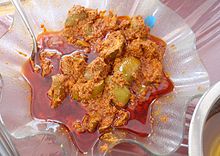Avakaya
 | |
| Alternative names | Aavakai |
|---|---|
| Place of origin | South India |
| Region or state | Andhra Pradesh/Tamil Nadu |
| Main ingredients | Mango, aavalu (powdered mustard), powdered red chilli, salt and oil,allam |
| Variations | Ginger |
Aavakaaya is a variety of Indian pickle popular in South India with its origin in Andhra Pradesh. The main ingredients are mangoes and aavalu (powdered mustard) and a combination of other spices used for pickling. South Indians are known to have a deep attachment to these spicy pickles. A wide variety of pickles are available in these regions, using mango as their prime ingredient. Besides being made at home, the pickles are available commercially and are exported to the United States, Europe, Japan and many other countries.
Preparation
Aavakaaya pickles are usually made in the summer, this being the time for peak availability of green mangoes. Green mangoes, hot oil, chillies and a variety of spices are the key ingredients. The process of preparation, storage and serving is considered almost a ritual.
The mangoes are cut into medium-sized pieces approximately 2 cm x 2 cm using strong and ultra sharp cutters/knives in swift strokes so as not to structurally damage the pieces. These pieces are wiped clean and dry with a highly-absorbent soft cloth — usually an old sterilized cotton sari with no embroidery, stowed away for this purpose. They are then pickled with powdered mustard, red chili powder (dried and powdered or sometimes dried, roasted and powdered), salt, gingelly oil and fenugreek (both in whole and powder form). Garlic is optional. The mixture matures for four to eight weeks, care being taken to mix the contents periodically to ensure a uniform marinade.
Popularity
Aavakai (Tamil version) is prepared during the pre-Summer seasons when mangoes are just about to ripe. The Tamil version, is not as spicy as the Andhra version and often contains chickpeas as one of the primary ingredients. It is prepared in many households and eaten along with curd rice.
Varieties

Aavakaaya is very popular in South India, especially in the state of Andhra Pradesh.
There is a wide variety of mango pickles, these include:
- Aavakaaya (The default one made with powdered mustard seed)
- Allam Aavakaaya (A spicy variety including ginger-garlic paste)
- Bellam Aavakaaya (A sweet variant of Avakaya made with jaggery)
- Dosa Aavakaya (Mango replaced with a type of dosakaya) (cucumber)
- Maagaya (Made with green, peeled, unstoned mango)
- Menthi aavakaaya or Menthikaaya (Includes fenugreek)
- Nuvvulu aavakaaya (Includes sesame)
- Paccha Aavakaya (Aavakaya with yellow chillies rather than red ones which are usually used.)
- Pulihora Aavakaaya (Aavakaaya with taalimpu (Telugu), called Chaunk in Hindi)
- Senagala Aavakaaya (Aavakaaya with the addition of chick peas or Bengal gram or chana)
- Thokku Maagaya (Maagaya includes the mango peel)
- Thurum Maagaya (Maagaya made with grated mango)
- Uduku Maagaya (Maagaya with boiled rather than raw mango)
- Usiri Aavakaya (Mango replaced with gooseberry)
- Vellulli Aavakaaya (Aavakaaya with addition of garlic)
- Yendu aavakaaya (Aavakaaya with pickled, dried mango cubes mildly sweetened with jaggery)
- kobbari aavakaya (aavakaya made with coconut flavor)
Consumption
Hot rice is mixed with one or two pieces of aavakaaya and ghee (clarified butter) or groundnut oil, then made into bite-size balls. Aavakaaya is often eaten with rice and yogurt. Raw onion can be added which enhances the taste. Most people prefer to eat it along with muddapappu (pigeon pea dal) and neyyi (ghee/clarified Butter). Some people prefer to eat it within 1–2 months from preparation, when it is called Kottaavakaya.
